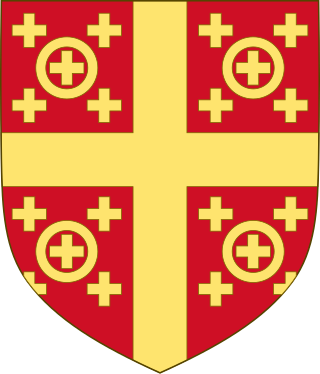Top Qs
Timeline
Chat
Perspective
Latin Emperor
Ruler of the Latin Empire (1204–61) From Wikipedia, the free encyclopedia
Remove ads
The Latin Emperor was the ruler of the Latin Empire, the historiographical convention for the Crusader realm, established in Constantinople after the Fourth Crusade (1204) and lasting until the city was reconquered by the Byzantine Greeks in 1261. Its name derives from its Catholic and Western European ("Latin") nature. The empire, whose official name was Imperium Romaniae (Latin: "Empire of Romania"), claimed the direct heritage of the Eastern Roman Empire, which had most of its lands taken and partitioned by the crusaders. This claim however was disputed by the Byzantine Greek successor states, the Empire of Nicaea, the Empire of Trebizond and the Despotate of Epirus. Out of these three, the Nicaeans succeeded in displacing the Latin emperors in 1261 and restored the Byzantine Empire.
This article needs additional citations for verification. (September 2014) |
Remove ads
Latin emperors of Constantinople, 1204–1261
Remove ads
Latin emperors of Constantinople in exile, 1261–1383
Summarize
Perspective

Latin Empire was disestablished in 1261, but Latin states in Greece, also known as Frankokratia, continued to recognize Latin emperors in exile as their overlords until 1383.
- Baldwin II (1261–1273), in exile from Constantinople
- Philip I (1273–1283), his son
- Empress suo jure Catherine I (1283–1307), his daughter, with
- Charles (1301–1307), her husband
- Empress suo jure Catherine II (1307–1346), their daughter, with
- Philip II (1313–1331), her husband
- Robert II (1346–1364), their son
- Philip III (1364–1373), his brother
- James (1373–1383), his nephew
James of Baux willed his titular claims to Duke Louis I of Anjou, also claimant to the throne of Naples, but Louis and his descendants never used the title.[1] However, there was further activity in regards to the imperial prerogatives of Latin Emperors. Louis' widow Marie of Blois claimed Achaea before selling the claim to Juan Fernández de Heredia.[2] In 1494 during his invasion of Naples, a new Capetian pretender King Charles VIII of France planned a crusade to claim Constantinople.[3] While his Neapolitan claim from Louis' line, the claim on Constantinople came from Byzantine prince Andreas Palaiologos.
In 1396, King Ladislas of Naples sold the rights to the Principality of Achaea to Pedro de San Superano, the leader of the Navarrese Company, ending the principality's formal vassalage to the Angevins.[4] Ultimately, Pedro did not have the funds to pay Ladislas, and through winning a family inheritance dispute that followed Peter's death in November 1402, Centurione II Zaccaria, a relative of Pedro (nephew of his wife) paid the owed sum, and became the new Prince of Achaea as per the original terms of the sale.[5]
By acquiring the title, Centurione gained the automatic right to claim other Angevin interests in the region, including territories and feudal obligations associated with the Angevin Principality of Achaea.[6] Centurione claimed the Latin imperial title "Despotus Romaniae" due to his possession of the principality, which was historically linked to the Angevin legacy and territorial claims, which included the Latin Empire. This title reflected his assertion of this new authority over regions that were part of the broader Angevin interest zone, which demonstrated his ambition to consolidate and expand his influence in the area.[7]

These feudal claims exercised over the existing latin vassals of the once Latin Empire included the right to demand loyalty and tribute from the respective lords, such as the Counts of Cephalonia and Zakynthos, based on previous feudal contracts.[8] one of whom, Carlo I Tocco simply usurped Centurione's title of "Despotus Romaniae" and also began to use it along with the similar but separate title of "Despotus Romeorum," which in fact was later confirmed by the Byzantine Emperor Manuel II Palaiologos.[7]
Remove ads
See also
References
Sources
Wikiwand - on
Seamless Wikipedia browsing. On steroids.
Remove ads








